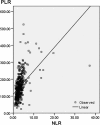Preoperative platelet lymphocyte ratio (PLR) is superior to neutrophil lymphocyte ratio (NLR) as a predictive factor in patients with esophageal squamous cell carcinoma
- PMID: 24641770
- PMCID: PMC3973187
- DOI: 10.1186/1477-7819-12-58
Preoperative platelet lymphocyte ratio (PLR) is superior to neutrophil lymphocyte ratio (NLR) as a predictive factor in patients with esophageal squamous cell carcinoma
Abstract
Background: Recent studies have shown that the presence of systemic inflammation correlates with poor survival in various cancers. The aim of this study was to determinate the prognostic value of the neutrophil lymphocyte ratio (NLR) and the platelet lymphocyte ratio (PLR) in patients with esophageal squamous cell carcinoma (ESCC).
Methods: Preoperative NLR and PLR were evaluated in 483 patients undergoing esophagectomy for ESCC from January 2005 to December 2008. The prognostic significance of both markers was then determined by both uni- and multivariate analytical methods. Receiver operating characteristic (ROC) curves were also plotted to verify the accuracy of NLR and PLR for survival prediction.
Results: High preoperative NLR (≥3.5 versus < 3.5, P = 0.039) and PLR (≥150 versus < 150, P < 0.001) were significantly associated with poor overall survival in multivariate analysis. However, our study demonstrated a better discrimination for the PLR in terms of hazard ratio(HR) than the NLR (HR = 1.840 versus HR = 1.339). Patients with NLR ≥3.5 had significantly poorer overall survival compared to NLR <3.5 (35.4% versus 57.7%, P < 0.001). Patients with PLR ≥150 also had significantly poorer overall survival compared to patients with PLR <150 (32.7% versus 63.5%, P < 0.001). The area under the curve (AUC) was 0.658 (95% confidence interval (CI): 0.610 to 0.706, P < 0.001) for NLR and 0.708 (95% CI: 0.662 to 0.754, P < 0.001) for PLR, indicating that PLR was superior to NLR as a predictive factor in ESCC.
Conclusions: Preoperative NLR and PLR were significant predictors of overall survival in patients with ESCC. However, PLR is superior to NLR as a predictive factor in patients with ESCC.
Figures



References
MeSH terms
LinkOut - more resources
Full Text Sources
Other Literature Sources
Medical

